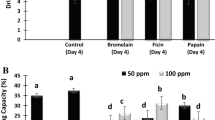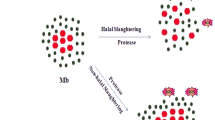Abstract
The meat portion directly attached to bovine hides (fleshing meat) is a by-product of leather industry that is a potential new source of proteins. In literature different enzymatic and chemical methods have been proposed to hydrolyze and solubilize fleshing meat. Enzyme hydrolysis is preferable for the mildness and the lower environmental impact. Enzymatic hydrolysates have never been deeply characterized, nor the specific enzyme efficiency, deeply investigated. In this study, the activity of six proteolytic enzymes was tested in order to determine their efficiency in solubilizing fleshing meat and to characterize at the molecular level the composition of the nitrogen fraction of the obtained hydrolysates. Total nitrogen content and the degree of hydrolysis were determined by Kjeldhal and o-phthaldialdehyde (OPA) methods. Amino acids and peptides were analysed by high performance liquid chromatography (HPLC) and mass spectrometry techniques. The results showed that papain and Alcalase appear to be the most efficient enzymes, and the corresponding hydrolyzates were rich in peptides and amino acids characteristic of collagen, notably absent in the hydrolyzates obtained with other enzymes. Thus, the ability to efficiently hydrolyze collagen seems to be related to the efficiency in fleshing meat hydrolysis.
Graphical Abstract


Similar content being viewed by others
References
Jayathialakan, K., Sultana, K., Radhakrishna, K., Bawa, A.S.: Utilization of byproducts and waste materials from meat, poultry and fish processing industries: a review. J. Food Sci. Technol. 49(3), 278–293 (2010)
Ózgünay, H., Çolak, S., Multu, M.M., Akyuz, F.: Characterization of leather industry wastes. Polish J. of Environ. Stud. 16(6), 867–873 (2007)
Buljan, J., Reich, G., Ludvik, J.: Mass balance in leather processing. United nations industrial development organization (2000) http://leatherpanel.org/sites/default/files/publicationsattachments/mass_balance.pdf
Sundar, V.J., Gnanamani, A., Muralidharan, C., Chandrababu, N.K., Mandal, A. B.: Recovery and utilization of proteinous waste of leather making: a review. Rev Environ. Sci Biotechnol. 10, 151–163 (2011)
Kumaraguru, S., Sastry, T.P., Rose, C.: Hydrolysis of tannery fleshings using pancreatic enzymes: a biotechnological tool for solid waste management. J. Am. Leather Chem. 93, 32–39 (1998)
Bajza, Z., Vrček, V.: Thermal and enzymatic recovering of proteins from untanned leather waste. Waste Manag. 21, 79–84 (2000)
Zhang, Y., Olsen, K., Grossi, A., Otte, J.: Effect of pretreatment on enzymatic hydrolysis of bovine collagen and formation of ACE-inhibitory peptides. Food. Chem. 141, 2343–2354 (2013)
Fernandez-Hervas, F., Celma, P., Punti, I., Cisa, J., Cot, J., Marsal, A., Manich, A.: The enzyme activity of trypsin on sheepskin trimmings in a two-step collagen extraction process. Am. Leather Chem Ass. 102, 1–9 (2007)
Damrongsakkul, S., Ratanathammapan, K., Komolpis, K., Tanthapanichakoon, W.: Enzymatic hydrolysis of raw hide using papain and neutrase. J. Ind. Eng. Chem. 14, 202–206 (2008)
Jian, S., Wenyi, T., Wuyong, C.: Ultrasound-accelerated enzymatic hydrolysis of solid leather waste. J. Clean. Prod. 16, 591–597 (2008)
AOAC. Official Methods of Analysis, 16th ed. Association of Official Analytical Chemists, Washington DC (2002)
Sigma Aldrich: http://www.sigmaaldrich.com
Spellman, D., McEvoy, E., O’Cuinn, G., FitzGerald, G.R.J.: Proteinase and exopeptidase hydrolysis of whey protein: comparison of the TNBS, OPA and pH stat methods for quantification of degree of hydrolysis. Int. Dairy J. 13, 447–453 (2003)
Church, F.C., Swaisgood, H.E., Porter, D.H., Catignani, G.L.: Spectrophotometric assay using o-phthaldialdehyde for determination of proteolysis in milk and isolated milk proteins. J. Dairy Sci. 66, 1219–1227 (1983)
Nollet, L. M. L.: Handbook of Food Analysis Physical Characterization and Nutrient Analysis, 2nd ed. Marcel Dekker, Inc., New York (2004)
Acknowledgements
This research has been carried out with the financial support by Cluster Agrifood Project 4 “Sustainability of the Italian food chain”, (Project So.FI.A CTN01_00230_450760). INALCA Industria Alimentari Carni Spa is gratefully acknowledged for the technological support and for the samples supply. Dr Andrea Faccini is gratefully acknowledged for LTQ-Orbitrap analyses made at the Interdepartmental Centre for Measures “G. Casnati” of the University of Parma.
Author information
Authors and Affiliations
Corresponding author
Electronic supplementary material
Below is the link to the electronic supplementary material.
Rights and permissions
About this article
Cite this article
Anzani, C., Prandi, B., Tedeschi, T. et al. Degradation of Collagen Increases Nitrogen Solubilisation During Enzymatic Hydrolysis of Fleshing Meat. Waste Biomass Valor 9, 1113–1119 (2018). https://doi.org/10.1007/s12649-017-9866-4
Received:
Accepted:
Published:
Issue Date:
DOI: https://doi.org/10.1007/s12649-017-9866-4




